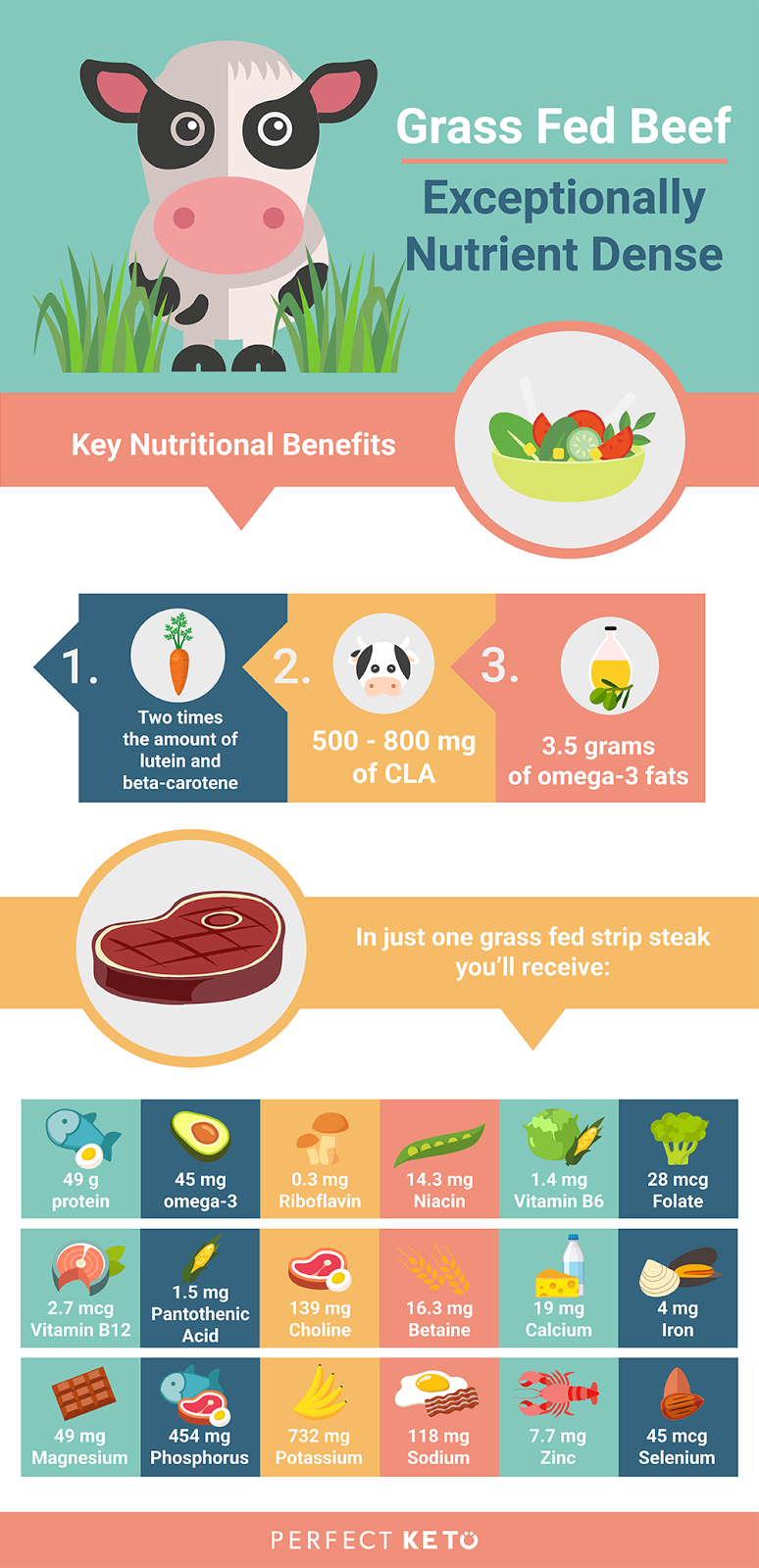Value of Grass Fed Natural Beef
Grass-fed beef is 1 of the almost nutrient-dumbo proteins y'all tin can buy. It has an extensive micronutrient profile and contains a proficient corporeality of brain-boosting omega-3 fat acids.
Nonetheless, some skeptics argue that there isn't a divergence between grass-fed and conventional beef.
Below, you'll larn the difference between grass-fed and grain-fed beef, seven unique health benefits of grass-fed beef, and where to buy information technology.
What's the Departure Betwixt Grass-Fed and Grain-Fed Beefiness?
Cattle are meant to graze on grass, preferably within open up pastures. As the demand for meat has grown over the by century, farmers started feeding their herds grain-based products, normally made from corn and soy[*]. The deviation between grass-fed and grain-fed beef pertains to their diet: in one, the animals are fed grass while they're alive, in the other, they're fed grain-based feed.
The Difference Between Grass-Fed, Grass-Finished, and Organic Beef
At that place is a lot of confusion surrounding grass-fed beef, mainly because it's not a USDA-regulated term. On Jan 12, 2016, the Agricultural Marketing Service, a branch of the U.S. Department of Agriculture, dropped grass-fed equally an official term, leaving things more than open to estimation[*].
Things to Know: The Difference Between Grass-Fed and Grass-Finished
With the removal of the USDA term, near any beefiness product could be labeled grass-fed. Nearly cattle raised by responsible farms graze in open pastures throughout the warmer months. Yet, it's pretty difficult to allow animals to roam freely in the winter, when snow covers the ground.
During these colder months, the cattle eat corn-and-soy based feed. Just, since they ate grass for office of (or for the majority) of the year, they could exist labeled grass-fed. In these cases, there is not much of a difference between grain-fed beef raised by a responsible farmer, and grass-fed beef.
If you are looking for beef that comes from a cow raised entirely on grass, await for the "grass-finished" characterization. These animals graze on grass in the summer and alfalfa in the winter. Nonetheless, know that this term is also non regulated by the USDA.
Is Grass-Fed Beef As well Organic?
Short respond: No.
Organic and grass-fed (or grass-finished) are 2 completely different things. "Organic" is a USDA-regulated term. Farmers need to complete a certification procedure, which can take upwardly to three years, to employ the organic label. Organic foods (such as organic beef) must exist produced or raised on a farm that doesn't use harmful pesticides, genetic engineering science (GMOs), or sewer sludge.
Every bit information technology pertains to beefiness, it is possible to buy organic, grain-fed beef. Cows from an organic farm were fed organic feed (i.east. organic corn- or soy-based products) during their lifetime. Organic animals must live in areas that encourage the welfare of the animal. These farms are inspected by a USDA-canonical organic-certifying agent[*].
What to Wait for When Purchasing Grass-Fed Beef
When you're in the market place for grass-fed beef, keep an eye out for products with the postage stamp of approving by the American Grassfed Clan (AGA).
Take the keto quiz
Discover the right keto snacks & supplements
for your unique goals
Take quiz
The AGA is known to exist the most trustworthy and guarantees the animals never received antibiotics or hormones and were never fed grains.
The Benefits of Grass-Fed Beef

Now that you understand the difference between grass-fed, grass-finished, and grain-fed beef, it'southward time to dive into a few key differences. While they come at a hefty toll point, grass-fed and grass-finished beef accept been shown to have a few benefits, including:
#1: Grass-Fed Beef Has Fewer Calories
"If y'all eat a typical amount of beef per year, which in the The states is near 67 pounds, switching to grass-fed beef will save you 16,642 calories a year," says EatWild.com founder Jo Robinson[*].
Beef from grass-fed cattle is lower in total fatty content considering their diet is more natural and clean. Although it would cost approximately $300 more a year, the amount of calories you can save is staggering.
#ii: Grass-Fed Beef Helps Support Healthy Blood Sugar Levels
Beefiness from grass-fed cows contains a certain beneficial fatty acrid chosen CLA (conjugated linoleic acrid). CLA can help prevent several diseases and conditions like obesity and diabetes[*]. A recent randomized, double-blinded study concluded that 37% of the people who were given CLA demonstrated meliorate insulin sensitivity over those who weren't given CLA. Insulin sensitivity helps promote good for you claret carbohydrate levels[*][*].
Consuming grass-fed beef while following a ketogenic lifestyle tin can improve blood glucose levels if y'all're insulin resistant. Utilizing a depression sugar, high-fatty ketogenic prevents a rise in blood glucose, which signals the release of insulin (and can eventually atomic number 82 to insulin resistance, a forerunner to diabetes).
#3: Grass-Fed Beef Contains Electrolytes
One common issue with people who brainstorm their keto lifestyle is the keto flu. This tin occur when electrolytes aren't replenished once they're flushed out. The three main electrolytes are sodium, potassium, and magnesium.
Fortunately, grass-fed meat has ample amounts of all three essential electrolytes. 1 grass-fed strip steak contains 732 milligrams of potassium, 49 milligrams of magnesium, and 118 milligrams of sodium.
#four: Grass-Fed Beef Helps Fight Cancer
Grass-fed beef contains roughly twice the amount of conjugated linoleic acid (CLA) compared to beefiness from grain-fed cows. Almost naturally occurring nutrients containing anticarcinogenic properties are derived from plant foods, but CLA is unique because it's one of the only anticancer nutrients derived from meat[*].
CLA is considered to be 1 of the strongest nutrients which can defend confronting cancer. A study conducted on women who were given high amounts of CLA-rich foods had roughly a 60% lower risk in breast cancer over those who had trivial to no amounts of CLA in their diet[*].
#5: Grass-Fed Beefiness Contains More Healthy Fats
Grass-fed beef provides up to half dozen times more omega–3 fatty acids than grain-fed beef. Grain-fed beef, on the other hand, contains higher levels of omega–6 fatty acids, which are already eaten in surplus in most standard American diets.
Hither are some of the benefits from increased omega–3 consumption:
- Alleviates Rheumatoid arthritis: Omega–3s are highly effective in decreasing all markers of inflammation[*].
- Helps with depression: Researchers accept seen an increase in mental well-existence by supplementing with omega–3 fatty acids[*].
- Helps yous focus: Recent studies conducted testify omega–3s to be a promising alternative to convalesce attention deficit disorders (ADHD) over stimulant medications[*].
#vi: Grass-Fed Beef Contains Less Bacteria
Some studies testify that conventional beef is more than prone to containing bacteria than grass-fed beefiness. Ane of the largest studies conducted past Consumer Reports analyzed 300 packages of footing beef. They constitute an antibiotic-resistant bacteria, methicillin-resistant staphylococcus aureus (MRSA), in 3 of the grain-fed samples and cypher in the grass-fed packages[*].
Additionally, they found eighteen% of the non-grass-fed beef samples containing superbugs — leaner that is resistant to more than three types of antibiotics — compared to merely 9% of beef samples from grass-fed livestock[*]. This is extremely rare, but tin lead to nutrient poisoning.
#7: Eating Grass-Fed Beefiness Can Decrease Your Risk of Heart Disease
Clinical bear witness concludes a decreased run a risk of center disease with an increased consumption of CLA, a nutrient abundant in grass-fed beef[*]. Grass-fed beef tin assist improve your heart wellness past:
- Antioxidants such as vitamin E
- Loftier amounts of omega–iii fatty acids
- Less unhealthy fats
- Lower amounts of bad cholesterol (known every bit LDL cholesterol) a marker of cardiovascular disease
What Makes Grass-Fed Beef Such a Nutrient-Dense Protein?

Grass-fed beef is an incredibly nutrient-dense poly peptide that tin can exist worked into almost any healthy diet. Grass-fed beef contains:
- Two times the amount of lutein and beta-carotene compared to grain-fed.
- 500–800 mg of CLA, which is up to three times the amount over grain-fed beef.
- Up to 3.v grams of omega–iii fats in grass-fed beef (the maximum corporeality for grain-fed is one gram).
In just one grass-fed strip steak (214 grams) you'll receive[*]:
- 49 one thousand protein
- 45 mg omega–iii fatty acids
- 0.iii mg Riboflavin (16% DV)
- 14.three mg Niacin (72% DV)
- ane.4 mg Vitamin B6 (70% DV)
- 28 mcg Folate (7% DV)
- 2.7 mcg Vitamin B12 (2.seven% mcg)
- 1.5 mg Pantothenic Acid (fifteen% mg)
- 139 mg Choline
- 16.3 mg Betaine
- 19 mg Calcium (2% DV)
- 4 mg Iron (22% DV)
- 49 mg Magnesium (12% DV)
- 454 mg Phosphorus (45% DV)
- 732 mg Potassium (21% DV)
- 118 mg Sodium (5% DV)
- vii.seven mg Zinc (52% DV)
- 45 mcg Selenium (64% DV)
Where to Purchase Grass-Fed Beef
Today, you can purchase grass-fed beefiness in nigh any grocery store, including large-chain grocers like Harris Teeter, Safeway, Giant, and Whole Foods.
If your local supermarket doesn't supply grass-fed products, you can reach out to a local farmer who raises grass-fed beefiness cattle in your area, or visit a farmers marketplace. This is an excellent strategy if y'all are looking for grass-finished products so you lot can speak to the farmer in person.
Finally, there are plenty of places to buy grass-fed products online. Butcherbox is an excellent visitor which mails grass-fed beef to your doorstep. EatWild.com contains a great directory where y'all can search for grass-fed farms in your area.
How to Cook Grass-Fed Beef
Grass-fed products cook faster than grain-fed products. To prevent burning your cut of meat, follow these cooking suggestions[*]:
- Grass-fed beefiness cooks approximately thirty% faster than grain-fed cuts, and so use a meat thermometer to prevent overcooking.
- Always use tongs over a fork when tossing the beef over.
- Make certain to preheat the grill, pan, or oven before cooking.
- Don't use a microwave to thaw out grass-fed beef. Thaw it in the refrigerator and let it sit at room temperature for thirty minutes.
- Because grass-fed beefiness is low in fatty, be sure to coat it with avocado oil or olive oil to make certain it doesn't dry out out.
Is it Worth the Extra Coin?
Grass-fed and grass-finished beef comes from cattle raised on grass or alfalfa for at least part of the twelvemonth. Unfortunately, grass-fed is no longer a USDA-regulated term. To ensure you lot're buying a quality production, purchase directly from a local farmer or look for beefiness with the AGA (American Grassfed Association) seal of approval.
Grass-fed beef has several health benefits. It contains more than vitamins and minerals, omega–iii fatty acids, and CLA than grain-fed beefiness. These nutrients have been shown to fight a number of diseases and ailments.
As with all food, e'er buy the highest quality you tin reasonably afford. If grass-finished, organic beef fits within your budget, go for it. If it doesn't, find a responsible farmer who raises their cattle on grass for at to the lowest degree part of the year.
Source: https://perfectketo.com/benefits-of-grass-fed-beef/

0 Response to "Value of Grass Fed Natural Beef"
Enregistrer un commentaire